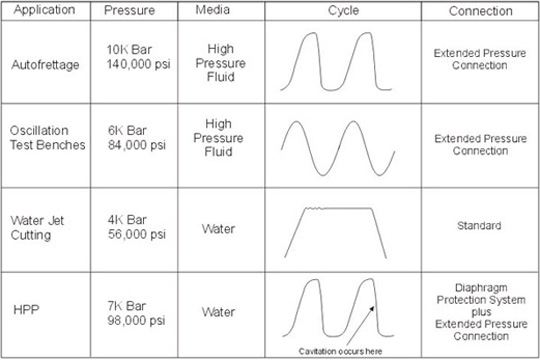When the application you are faced with involves ultra-high pressure measurement, turn to WIKA’s
HP-2 pressure transmitter. The HP-2 is designed for superior maximum pressure for applications up to 225,000 psi, or 15,000 bar. And because of its special cavitation protection, you can count on the HP-2 to provide precise results for a long time. What does that mean for you? A reduction in running costs and reduced downtime in the plant, making the HP-2 the economical choice. Not only that, but the HP-2 is compact.
However, don’t let the small size fool you. It can do big-time work. Here are six applications where the HP-2 pressure transmitter excels.
Autofrettage
A pressure valve is subjected to enormous pressure during a metal fabrication process known as autofrettage. Internal portions of the valve yield, causing internal compressive residual stresses. Autofrettage is intended to increase the durability of the final product and is commonly used in manufacturing fuel injection systems for diesel engines, battle and tank cannon barrels, and high-pressure pump cylinders. The HP-2 helps ensure that the amount of pressure applied guarantees maximum strength and expansion of the subject. If it doesn’t, the product will not reach its maximum strength capability.
Test benches
Used in pressure or flow testing of system components, test benches can be used in the automotive industry for gasoline and diesel engines, solenoid valves, and truck transmissions. Fuel cell, turbo-generator, and wind turbine test benches are used to test power-generation equipment. In addition, test benches can be used for gas turbines, screw compressors, fluid flow dynamics, industrial valves, and medical devices. Applications in the ultra-high pressure range are growing with the manufacturing of diesel injection components such as nozzles and rails or even just pipes.
The HP-2 helps ensure the functional testing can be carried out at working pressure or under increased test pressure: a crucial factor since these test benches work to increase the lifetime of diesel engines. In these applications, test benches provide high precision and a controlled constant temperature.
Functions of Diesel Engine Test Bench:
- Check and adjust the distributor pump
- Measure each cylinder’s delivery art various rotation speeds
- Check and adjust the mechanical speed governor
- Measure the reflux delivery of the distributor pump
- Measure the distributor pump’s internal pressure
Water Jet Cutting
The extremely high water pressures required for water jet cutting must be accurately regulated and measured. The cutter is commonly connected to a high-pressure water pump where the water is ejected from the nozzle. During the process, water is able to cut through just about anything-- from prepared foods to metals—by spraying it with the jet of high-speed water. The cutting stream can easily be modified to adjust to the materials being cut.
Proper water jet velocity and distribution is crucial in water jet cutting applications, and that’s where the HP-2 pressure transmitter comes into play. Knowing the water jet velocity, the user can determine the specific performance of the components used in the cutting process.
High-Pressure Processing
During high-pressure processing, or HPP, intense cold water pressure is used to protect against harmful bacteria without affecting a food product’s taste, texture, appearance, or nutritional value. Products are packaged, sealed, and then placed in a cylindrical pressure vessel where they are surrounded by water. Pressure is intensified with a hydraulically driven piston. Process pressures, hold times, and temperatures are controlled electronically. The HP-2 pressure transmitter plays a big role in exerting up to 87,000 pounds of water pressure per square inch, protecting against harmful bacteria and sealing in freshness and flavor naturally. No preservatives needed.
Hydroforming
A well-defined process, hydroforming is a lucrative way of shaping flexible metals into lightweight, sturdy pieces. Hydroforming uses fluid pressure instead of mechanical striking pressure to form the part into the desired shape of the die. The process is extremely valuable in producing whole components instead of components made up of multiple parts. WIKA’s HP-2 pressure transmitter constantly monitors the distribution of hydraulic fluid during the process. If the hydraulic fluid is not distributed correctly, the finished product will contain errors. It makes certain that proper monitoring of pressure is in place, ensuring product excellence.
High-Pressure Cleaning
High-pressure cleaning uses water propelled at high speeds to clean surfaces and materials. The water stream is focused and pressurized, allowing the removal of hard-to-remove materials such as rubber from airport runways, sealants and membranes from concrete, and paint from walls, highways, and metal. The HP-2 is also used in high-pressure applications when water is used to prepare various surfaces for repair or to reapply required coatings.
For more information about the HP-2, contact a WIKA representative.
